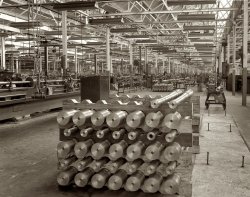
MAY CONTAIN NUTS

Search Shorpy
SHORPY ART

Framed or unframed, desk size to sofa size, printed by us in Arizona and Alabama since 2007. Explore now.
Join and Share
Ad-Free Shorpy
Shorpy is funded by you. Patreon contributors get an ad-free experience.
Learn more.

Recent comments
- Freeze Frame
- Texas Flyer wanted
- Just a Year Too Soon
- WWII -- Replacing men with women at the railroad crossing.
- Yes, Icing
- You kids drive me nuts!
- NOT An Easy Job
- I wonder
- Just add window boxes
- Icing Platform?
- Indiana Harbor Belt abides
- Freezing haze
- Corrections (for those who care)
- C&NW at Nelson
- Fallen Flags
- A dangerous job made worse
- Water Stop
- Passenger trains have right of way over freights?
- Coal
- Never ceases to amaze me.
- Still chuggin' (in model form)
- Great shot
- Westerly Breeze
- For the men, a trapeze
- Tickled
- Sense of loneliness ...
- 2 cents
- Charm City
- What an Outrage
- Brighton Park
Member Photos
The Shorpy
Print Emporium
Print Emporium
Search Shorpy
Search results -- 30 results per page
- Factory Air: 1942
- ... Goodrich Co." View full size. 4x5 nitrate negative by Alfred Palmer.
(The Gallery, Alfred Palmer, WW2) ... Posted by Dave - 09/05/2012 - 4:12pm -
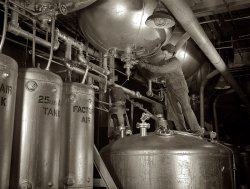
- Colossus: 1942
- ... Dam. View full size. 4x5 Kodachrome transparency by Alfred Palmer. An amazing photograph.
(The Gallery, Kodachromes, Alfred Palmer) ... Posted by Dave - 08/03/2012 - 3:30pm -
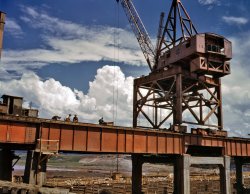
- Turn, Turn, Turn: 1942
- ... ultimate of 96,000 kilowatts." Medium format negative by Alfred Palmer for the Office of War Information. View full size.
When you have ... Posted by Dave - 01/23/2017 - 1:59pm -
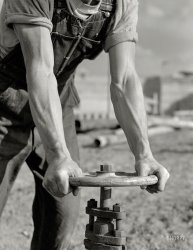
- Chattanooga: 1942
- ... View full size. 4x5 Kodachrome transparency by Alfred Palmer.
(The Gallery, Kodachromes, Alfred Palmer, Industry & Public Works) ... Posted by Dave - 08/03/2012 - 3:28pm -
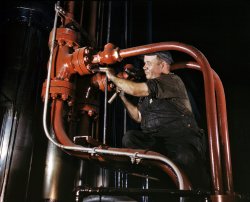
- We Mean Your People No Harm
- ... View full size. 4x5 Kodachrome transparency by Alfred Palmer.
(Technology, The Gallery, Kodachromes, Alfred Palmer) ... Posted by Dave - 07/23/2012 - 10:49am -
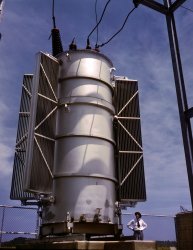
- Well-Rounded: 1942
- ... for high altitude flying." 4x5 nitrate negative by Alfred Palmer for the Office of War Information. View full size.
(The Gallery, ... Posted by Dave - 04/21/2008 - 5:18pm -
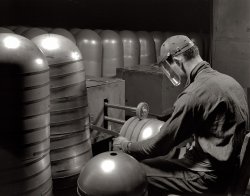
- Party Girl: 1942
- ... View full size. Medium format negative by Alfred Palmer for the Office of War Information.
Strange look Sergeant French ... Frank L. Vineyard, 1921-1998. - Dave]
(The Gallery, Alfred Palmer, Kids, Pittsburgh, WW2) ... Posted by Dave - 09/11/2011 - 11:34am -
![Party Girl: 1942 August 1942. "George Woolslayer celebrated the visit of the soldier and sailor with a party at his home. Friends, relatives and fellow workers made up the list of guests. No ordinary party, this one will be remembered by the Woolslayers for years to come. Festivities started at 8 p.m. and lasted well into the next morning. Proudly seated on Sergeant French L. Vineyard's knee is Woolslayer's 8-year-old daughter, Georgia Ann, who stayed up long past her bedtime to take part in the fun. Allegheny-Ludlum Steel, Pittsburgh, Pennsylvania." View full size. Medium format negative by Alfred Palmer for the Office of War Information.
Strange lookSergeant French L. Vineyard has a strangely predatory look in his eyes, I wonder what he just said to little Georgia Ann that has her smiling in such a coquettish manner.
This photo is a little creepy, actually.
Take a second look.This picture reminds me of myself a lot. When I go to other friends' places, their kids just seem to flock to me. They climb on my lap and make themselves comfortable. I give them the look – What do you think your doing? The more I growl the more they seem to like me. These two are just getting along fine and that is all that is going on.
Sgt. F.L. VineyardFrench Vineyard is one of the most unGoogleable names I've ever come across.
A Model SoldierThere is a small photo of Sergeant Vineyard (who looks much nicer than in the one at the party) in the Washington Post of March 11, 1942.
His collar is undone and he has pulled his shirt open, like Superman. The caption reads, "Sergt. French L. Vineyard shows how American soldiers will wear two identification tags bearing the soldier's name, serial number, religion, blood type, date of tetanus immunization and the person to be notified in case of emergency. The new tags, of stainless and rustproof monel metal, replace the aluminum disk used by United States troops in World War I, which did not contain the valuable medical information."
The article does not say, but I understand that there were two "dog tags" so that if a soldier was killed, one could be taken for record keeping and one could be left with the body for identification when it was recovered later.
Sgt. VineyardVineyard's a bit of an unusual name. There is a listing for Sgt. Louis R. Vineyard of Oklahoma, of the 743rd Bomber Squadron, 455th Bomber Group (heavy) on the American Battle Monuments Commission web page for WWII burials overseas. He died on 20 December 1944 and is buried at the Sicily-Rome American Cemetery in Nettuno, Italy. Brother, perhaps?
[There are over 1,400 Vineyards in the Social Security Death Index. Including one Frank L. Vineyard, 1921-1998. - Dave]
(The Gallery, Alfred Palmer, Kids, Pittsburgh, WW2)](https://www.shorpy.com/files/images/8e11120u.thumbnail.jpg)
- True Blue: 1943
- ... dive bomber." 4x5 inch Kodachrome transparency by Alfred Palmer for the Office of War Information. View full size.
Drusilla the ... Posted by Dave - 06/01/2018 - 4:51pm -
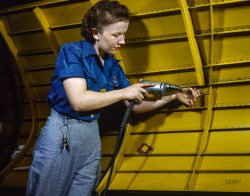
- How to Bed a Balloon: 1942
- ... bed down a big barrage balloon." Photos by Pat Terry and Alfred Palmer for the Office of War Information. View full size.
Signal Hill ... Posted by Dave - 05/25/2013 - 3:42pm -
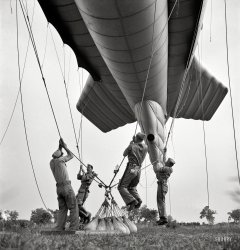
- Electric Steel: 1942
- ... the fluidity of the steel." 4x5 Kodachrome transparency by Alfred Palmer for the Office of War Information. View full size.
Beautiful! ... Posted by Dave - 05/29/2018 - 2:13pm -
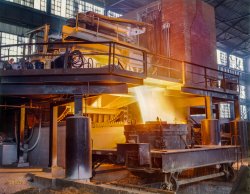
- Time to Make the Donuts
- ... View full size. Amazing 4x5 Kodachrome transparency by Alfred Palmer.
Amazing!
It looks like a Amazing!
It looks like a photo ... Posted by Dave - 08/05/2012 - 9:27am -
![Time to Make the Donuts June 1942. Truck driver at the Tennessee Valley Authority's Douglas Dam. View full size. Amazing 4x5 Kodachrome transparency by Alfred Palmer.
Amazing!
It looks like aAmazing!
It looks like a photo taken in a studio with a complex lighting setup. Or maybe a modern HDR photo. Hard to believe it was taken in the forties.
I love the color!I love the color of these Kodachrome transparencies you're posting. Absolutely marvelous! Please post more if you got 'em.
[Glad you like them. For many if not most of the ones we are posting, this is the first time they've been seen in all their high-res, color-corrected glory. - Dave]
Color correctionDave,
What color correction do you do to Kodachromes? Do 40s Kodachromes need any? I believe this particular emulsion should be good for something like 180 years when stored dry and dark.
BTW: Love this site and visit twice a day at least to see if there is something new. The photographs by Jack Delano that you put up made me buy 48 rolls of Kodachrome 64: great stuff while it lasts.
[Thanks. There was no color correcting for this one aside from hitting Auto Color in Photoshop, which will remove any color cast. Then there is usually a bit of tweaking with the Shadows and Highlights filter. One reason these look so nice is the large film size. The 4 by 5 inch Kodachrome sheets used to make these pictures have 18.4 square inches of usable surface area, which is 18 times as much as a 35mm film frame, which gives almost exactly one square inch. So there is a lot more information to work with. The archival tiffs for these images are from 130 to 200 mb in size. The Delano pictures tend to be underexposed and require a bit more tweaking. Below is a Delano shot with the before-and-after versions in alternating stripes. - Dave]
ExposureDave,
Thanks for taking the time for your comprehensive reply. Although I have a Graflex Crown Graphic 4x5, I am resigned to using it with Ektachrome 100 EPP readyloads, as Kodachrome is nowadays available in 35 mm only. The Kodachrome goes in a Leica M6 TTL therefor and has to be sent to Kansas (the only remaining K14 lab in the world) for processing.
The original Delano slide looks underexposed by at least a full stop and certainly benefits from your post processing. If Delano exposed like this consistedly, I wonder why.
Keep up the good work!
[The darkness of some of these may have to do with the settings used by the contractors who digitize these for the LOC. They may be erring on the side of caution. You can usually extract a nice picture from the tiff of an underexposed sheet whereas with an overexposed image you are pretty much stuck with what you see. - Dave]
Original Kodachrome FilmWe must remember that the original Kodachrome film was ASA 10 and very contrasty. It was hard to overexpose it! Kodachrome II (ASA 25) came out around 1960 and was far better.
These photographs are just so good! I can't tear myself away from the computer until I've seen them all. GREAT work, Dave.
Scanner?Can anybody comment on the scanner used for these shots?
[There is no scanner. The LOC transparencies are digitized using a Sinar studio back, which is something like a regular digital camera (but without a light source, which the user has to supply along with a lens, if one is needed). Basically a giant CCD array that records an image in one to four exposures. - Dave.]
(The Gallery, Kodachromes, Alfred Palmer, WW2)](https://www.shorpy.com/files/images/1a35238u.thumbnail.jpg)
- American Iron: 1942
- ... Pennsylvania." 4x5 inch Kodachrome transparency by Alfred Palmer for the Office of War Information. View full size.
(The Gallery, ... Posted by Dave - 05/29/2018 - 1:17pm -
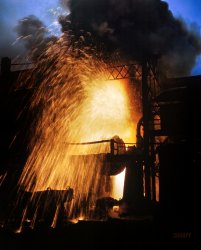
- Balloon Jockeys: 1942
- ... Corps ground crew." Medium format negative from photos by Alfred Palmer and Pat Terry for the Office of War Information. View full size.
... Posted by Dave - 10/29/2016 - 12:16am -
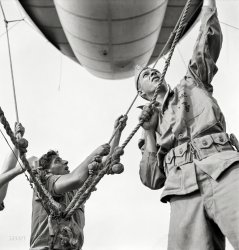
- Frozen: 1943
- ... require removal of point stamps." 4x5 acetate negative by Alfred Palmer, Office of War Information. View full size.
Egg before chicken ... Posted by Dave - 09/29/2020 - 7:14pm -
![Frozen: 1943 February 1943. Washington, D.C. "Preparation for point rationing. While Mother keeps handy her War Ration Book Two, daughter examines the frozen foods which require removal of point stamps." 4x5 acetate negative by Alfred Palmer, Office of War Information. View full size.
Egg before chickenSlightly over half of Americans owned refrigerators before the war, and freezer sections were just large enough for two ice cube trays, and little more. You couldn't buy a new fridge during the war, or for a couple of years after that, either.
[On the other hand, the stores wouldn't be selling all this frozen food if people didn't have a place to keep it. - Dave]
As a small childI remember those frozen vegetable packages. The wrapper was a heavy waxed paper. No plastic back then.
Frozen = leftoversWe used to buy frozen veggies and cook them the same day, then we would refrigerate the leftovers. They were good for a few more days when refrigerated. Did the same with frozen fruit too. We had an ice box, then a fridge with the minuscule freezer, not room to keep much of anything frozen. We never had ice cream in the freezer, that's what made going to town for ice cream so special. I still take the wife out for an ice cream on occasion.
Grandmother's ChestFrozen food became considerably more common after WWII, when home freezers were again available. My grandmother bought one in 1946 and how well I remember those delightful frozen peas and corn, unlike those mushy canned offerings. And having fudgesicles at home--heavenly. When she died my wife and I inherited the chest-type freezer, and used it for nearly forty more years. In all, it lasted more than fifty. They don't make 'em like that now.
Crooner Bing Crosbyhad a lot to do with the frozen food industry back then, especially with frozen orange juice.
Vegetables for 13, Please AlexWhat is the 13-pointer in the freezer corner, right under the young lady's hand? It's the most expensive item in the freezer. It looks like it starts with "AN", but an internet search doesn't turnip (pun intended) any vegetables starting with "An". Could be rhubarb if that's not an "AN". Would rhubarb command a ration points premium of 13?
[It is indeed rhubarb. - Dave]
Keeping frozen foodWhen I was kid (around 1953) we had one of those refrigerators with a tiny freezer compartment. My mother generally had a couple of boxes of frozen veggies in there, which was all that would fit. The winter fresh vegetable selection on the east coast was pretty thin, and expensive, so we had frozen and canned. It wasn't until around 1960 that we got a separate freezer in the garage.
The revolutionary Clarence BirdseyeAs a fan of Mark Kurlansky's writings, I recommend his book "Birdseye: The Adventures of a Curious Man." From the jacket:
While working as a fur trapper in Labrador, Canada, Clarence Birdseye encountered an age-old problem: bad food and an unappealing, unhealthy diet. However, he observed that fresh vegetables wetted and left outside in the Arctic winds froze in a way that maintained their integrity after thawing. As a result, he developed his patented Birdseye freezing process and started the company that still bears his name. Birdseye forever changed the way we preserve, store, and distribute food, and the way we eat.
(The Gallery, Alfred Palmer, D.C., Kids, Stores & Markets, WW2)](https://www.shorpy.com/files/images/SHORPY-8b05908a.thumbnail.jpg)
- Army Mechanic: 1942
- ... View full size. 4x5 Kodachrome transparency by Alfred Palmer for the Office of War Information.
Motor Mechanic A much better ... Posted by Dave - 07/24/2012 - 9:38pm -
![Army Mechanic: 1942 June 1942. Fort Knox, Kentucky. "A good job in the air cleaner of an Army truck. This Negro soldier, who serves as truck driver and mechanic, plays an important part in keeping Army transport fleets in operation." View full size. 4x5 Kodachrome transparency by Alfred Palmer for the Office of War Information.
Motor MechanicA much better job than being shot at, and directly transferable to civilian life.
Studio?Maybe this has been asked before, but would this have actually been a studio shot? The smooth blue background makes me wonder.
[Outdoors. All of these were on location. The OWI and FSA programs were documentary photography, if not exactly candid. A lot of the large-format Kodachromes were posed and used auxiliary lighting. But the people in them weren't models and weren't in studios. - Dave]
4x5 KodachromesRobcat asked if this was a posed or studio photo. As mentioned above the photo was on location. The 4x5 inch size Kodachrome 10 film was usually used in a Speed Graphic camera with individual "cut film holders." A sheet of film was placed into the holder whilst the loader was inside the darkroom. A "dark slide" was slipped across the open side of the film holder to protect the negative. When the photographer was ready to make the picture, the "dark slide" was pulled out and usually placed into a pair of spring clips on the back of the ground glass shield of the camera. Then the camera lens was cocked, the various exposure settings were calculated, and the photograph framed in the viewfinder. Then the photo was made by tripping the shutter release. The dark slide was then replaced and the film holder removed by sliding outward to the right. It was then placed into the photographer's pouch on the side reserved for "exposed." The dark slide had a black stripe on the side so that you could look at the holder and determine if the film had been exposed. Unless you forgot to flip the slide around from the black stripe to the silver stripe and vice versa. Next, during the actual exposure of the picture, most times, a #25 flashbulb was used; the Speed Graphic had a tubular flash holder and reflector. This was called "fill-in flash" and was used to eliminate deep shadows, which Kodachrome 10 didn't particularly portray (there would be a black muddle). Remember also that the film was "ASA 10" Speed. Today we use the ISO system, and your usual digital camera exposes at about an ISO 200 rating. ASA 10 is many times "slower" than an ASA 100 film, which would have been Black and White, since there were no high speed color films in those days. The granularity ("grain") of Kodachrome 10 in 4x5 inch size makes possible huge enlargements upwards of 5 feet by 8 feet in size. You will notice that these photos are amazingly "clear" and have a robust depth to them. This is due in part to the very fine grain of the film and the fact that it was done with large format film. An equivalent in a modern digital camera would be about a 25 to 50 megapixel image. There were larger format cameras, up to 11x14 behemoths. Almost always, the negatives from 5x7, 8x10 and 11x14 inch view camera were "contact printed," that is the transparency was placed on top of the photo paper and held down with a sheet of glass (usually an old window pane). Then light from the enlarger or the room lights wold be flashed on and off for a second or two. Once you see a contact print made from a fine grain 8x10" Kodachrome 10 which was processed to a negative rather than a positive, you will not be able to take your eyes off of it. Stunning in its depth. I used to do certain types of laboratory photos while I was in the US Army and used a Sinar 8x10 view camera. Today, you couldn't afford to buy the film for it .. something like $25 per sheet for a color negative film. Hope anecdote helps .. I've been a photographer for a little more than 50 years. I use a Canon Rebel digital now and it is the Cat's Meow, to be sure!
Amazing!I've yet to see anything coming out of a digital camera that looks like this. This image, and the other Kodachrome images on this site simply achieve the vibrant colors of the skin, the fabric, and the texture of shiny metal .. and worn industrial parts that transports the viewer to a different time and place .. with a realism that evokes a feeling lacking in modern two dimensional images .. it certainly changes everything I've come to know and appreciate with digital capture.
We all travel different roads in photography, perhaps the digital highway is not as scenic as that already traveled with film.
KodachromeOriginal Kodachrome was known for its bright and posterish colors, fine grain and stability. I have 50 year-old Kodachrome slides that are as bright as the day they were taken, while a good many of my Ektachromes from that time have faded to red. As fine as 35mm slides were, 4X5 transparencies are incredibly detailed, just because they are big. Kodachrome was reformulated and introduced as Kodachrome II in 1961. It was ASA 25 and had more accurate color than the original, but retained its fine grain and stability. When I shoot film these days, though (mostly in one of my old 3D cameras), I prefer Kodak Elite because of its brighter colors.
KodachromeKodachrome was a very special film in my estimation. When I was serious about photography years back I shot some with the Kodachrome that was available at the time (25 and 64) and was always stunned by the quality of the colour. Most of the time I shot Ektachrome (cost and film speed considerations) and Kodacolor for prints and there was no comparison between them - Kodachrome won every time.
WowIf it weren't for the date on the bottom of this photograph, I would have thought this shot was taken a lot more recently. I didn't know that older photographs could look so vibrant.
But the subject 1942 and they still feel it necessary to point out his color. Had the subject been white, I doubt more than his name would have been cited. Perhaps the authors sought to popularize the idea of enrolling amongst the Negro population, many of whom were questioning how patriotism and Jim Crow could co-exist. But volunteer they did, in droves, while the Tuskeegee Airmen were heaped with well deserved praise, American Blacks served in all branches with distinction. My dad owed his life to an African American soldier who dragged him into a foxhole during a Japanese attack.(Thank you Walter, I wish I knew your last name.)
(The Gallery, Kodachromes, Alfred Palmer, Cars, Trucks, Buses, WW2)](https://www.shorpy.com/files/images/1a35222u_0.thumbnail.jpg)
- Power of Tower: 1942
- ... Island, South Carolina." 35mm Kodachrome transparency by Alfred Palmer for the Office of War Information. View full size.
Naval ... Posted by Dave - 05/28/2018 - 6:52pm -
![Power of Tower: 1942 May 1942. "Marine lieutenant by the power towing plane for the gliders at Parris Island, South Carolina." 35mm Kodachrome transparency by Alfred Palmer for the Office of War Information. View full size.
Naval Aircraft FactoryFairly sure this is an N3N primary trainer. Like many US biplanes from the interwar period, they were an attractive little machine.
Kodachrome!I love these Kodachromes! Please keep 'em coming. Great stuff.
Popular color Apparently that shade of yellow was very popular with the wartime suppliers. I have seen it multiple times on planes, jigs, and plant equipment. Wonder if there was some reason it was so widely used.
[It's a primer coat. -tterrace]
Yellow Butyrate DopeThe yellow in this case is not zinc chromate primer. It's conventional yellow butyrate airplane dope. Zinc Chromate was used in some applications over aluminum to make the paint stick better by chemically interacting with the oxide layer that forms over bare aluminum. Dope doesn't stick to any non-porous material very well (except itself), so this was necessary to have it stick. It also reduces corrosion when exposed to salt water (which is relevant because the planes were delivered by ship - and corrosion damaged entire manufacturing runs of various airplanes). It's not a pure yellow, it's more greenish (as shown in the B-25 pictures).
This airplane had some area of aluminum, but a lot of it was covered with fabric (linen, probably) that needed to be painted with something to seal it up, hence, airplane dope. It would seal the material against moisture, and also shrink and draw the covering tight. Why they chose yellow, I don't know, but the standard paint scheme at the time was yellow and a medium-light blue. That is the yellow here, it's a Federal Standard paint color.
Combat glidersThose were the helicopters of their day. And that must have been one of the most scary piloting jobs ever.
Landing an aircaft without propulsion, under enemy fire, in the dark, on unknwon (and next to invisible) terrain - sounds like a crash to everybody else. No second guesses (a.k.a. go-around), either. The US glider pilots had a "G" on their wings. And rightfully claimed "G is for guts".
There are two very good accounts, one by a Gerard M. Devlin (Silent Wings), and one by John L. Lowden (Silent Wings at War).
And the crazy things they did with medevac and bungees.
But all things considered recreational glider flying is much preferable.
Yellow PerilThe yellow was standard naval aviation color for a trainer plane. It was simply a conspicuous marking of a beginning pilot, to warn other pilots and ground crew not to necessarily expect normal or competent behavior!
Trainers were often referred to as "Yellow Perils." Tighten your seatbelt and helmet straps!
(The Gallery, Kodachromes, Alfred Palmer, Aviation, WW2)](https://www.shorpy.com/files/images/SHORPY-1a35116u.thumbnail.jpg)
- The Jolly Market: 1965
- ... the perennial butt of jokes in Mad Magazine; one cover had Alfred E. Neuman cutting a line of them with a lawnmower.
I don't actually ... like Eugene Levy checking out Winona Ryder and Arnold Palmer.
Like I love most of the "Tterrace Collection," but this is one ... Posted by tterrace - 09/29/2011 - 6:15pm -
![The Jolly Market: 1965 My father makes change for a couple of my acquaintances in the Jolly Market in Fairfax, California. A year later he retired from full-time employment, but took on part-time work at a couple Marin County supermarkets for a few years thereafter. This being the days before scanners, you'll note the market's latest weekly newspaper ad hanging there for reference. The triangular-shaped gizmo at the upper right corner of it is a trading stamp dispenser, probably Blue Chip. A few years later we were using them at the post office counter to sell postage stamps. Also of interest, conveniently located on the counter adjacent to the razor blades, is a dispenser of do-it-yourself last will & testament forms, thus providing a complete impulse buy solution for the customers. Finally, at no extra charge, hilarity-inducing facial expressions. A somewhat underexposed, fluorescent-illuminated available light Kodachrome that I boosted and color-corrected.
Smoking In The StoreMy first "real" job was bagging groceries at the local supermarket in the early '70s. At least in small town Nebraska, smoking was certainly permitted inside the store. We had ashtray stands at the end of every aisle, and a couple times per shift someone had to go up & down the aisles and sweep up cigarette butts. No scanners - each item was individually priced, either with a rubber stamp or a sticker gun. And we closed promptly at 6 every night, an hour later than the downtown shops - except on Thursdays, when every store in town stayed open till 9 and the farmers came to town to shop. It really was a different world.
Bar codesEvery packaged product in the late '70s had a bar code, but few people seemed to have any idea what for, since scanners were not yet in evidence. They were the perennial butt of jokes in Mad Magazine; one cover had Alfred E. Neuman cutting a line of them with a lawnmower.
I don't actually remember seeing anyone smoke in a supermarket, but one of my earliest memories is of reaching down to pick up a butt in the aisle, out of curiosity, since no one in my family smoked, and I wasn't sure what it was. Of course my mother told me to put it down because it was dirty. This would have been in the early '70s. I do remember seeing ashtrays atop the posts that held the velvet ropes in the bank, well into the '80s. Indoor smoking was of course verboten by that time, but the accoutrements remained.
Double TakeWow! I had to do a double take with this photo. Though your dad appears to be shorter in height than my dad, your father looks just like my dad in this photo. Maybe it is his expression, or the shape of his face and nose, and the glasses, but your father, in this picture, could almost pass for my dad. I have not seen such a similarity to my dad in other pictures of your father though.
I'm with the BillsBdgBill is right that a photo you probably barely noticed at the time has aged very well, and RGMBill is right that the man wouldn't look out of place 45 years later, while the woman's dress is, well, severely retro.
There is so much going on in this photo. Why is the older man with the younger woman? Why does she have a flower behind her ear? Why is she looking at your father so intently? A great slice of life photo that is thought-provoking nearly a half-century later.
A Trip to the StoreThis was during my formative years, and I always liked going to the grocery store (Food Fair). The gumball machines, the electric door at entrance, the big Toledo scale, the Coke machine, and the candy racks at the register (Life Savers, Wrigley's Spearmint, Doublemint) were highlights. If I was really lucky, there would also be a stop at the gas station (Cities Service).
Did your dad ever have to deal with shoplifters, drunks or robbers? I'm sure he encountered his share of characters.
Ordinary Photos Age Well You probably barely gave this shot a look when it was first processed. Almost nobody would have found this to be an interesting photo when it was first shot but as images like this age, they get more and more interesting.
I really enjoy these occasional mid to late 20th century photos here on Shorpy. Keep them coming.
Do you remember if customers were allowed to smoke in grocery stores back in the day? I seem to remember my mother smoking while walking the aisles of our local Stop n Shop back in the early '70s but she strenuously denies this.
Cute CoupleI bet those two were fun beyond belief.
Service With A SmileI must admit that although we enjoy amazing conveniences and ease of living these days, the old time personal service could not be beat. If you have tried to use those "self-checkout" lanes in most big markets these days, you will see that in almost every instance a manager/cashier must be called over anyway (with further delays) because the sale price did not scan or coupons could not be used or for any other number of glitches that were wrongly programmed. As for "impulse item space" at the checkout, that was always a hot property for manufacturers to win for their product. I worked for Bic Pen in the 60's and they would do anything for that point of sale display as did Gillette Blue blades. Years later, when I had kids, they would desperately want to spend their entire allowance before we left any store and were buying TV Guides, gum, nail clippers, etc. just anything to use up their $2. This photo is wonderful and totally realistic, a blast from the past, I love it. Thank you Shorpy and tterrace.
8:24 pmHugging by your dad's watch.
The man could have stepped into the supermarket here today and no one would look twice. The girl -- well, fashions have changed, although folks might still look at her twice.
["Hugging"? If you say so. - Dave]
Dad seems to be thinkingEverywhere I go that kid of mine is taking my picture.
Great photo, something about old Supermarkets gives me a very nostalgic feeling.
I can remember going to the Safeway back around 1963-64 and being fascinated by the Coffee aisle, they had a grinder then and you ground your own beans, great stuff for a four year old boy.
I can remember the music too, or maybe it was Muzak, dreary instrumental stuff with lots of muted horns.
Butts in the fruits and veggiesYeah, people could smoke in the grocery. I remember, as a kid in Southern California around 1970, going to the store to get an orange or apple for a snack. While picking one out I noticed that unthinking individuals used to toss their butts right into the fruit and veggie bins. I guess the produce folks had to do the butt removal as well as restacking the fruit. Yuck!
Introduction to ItalianTterrace, I don't know how you wound up with the nickname "termite." Especially with your family's Italian heritage, I'm surprised your friends and family didn't call you "Paparazzi."
At First GlanceIf I didn't know better, it looks like the customer feels he's been short changed.
Speaking of scannersI get a kick out of looking through Reader's Digests that came out around the time I graduated high school (1979). Just for giggles, I pulled a 20 cent off coupon for soup out of one a few weeks back and took it to Safeway, mostly to see the cashier's reaction upon realizing it expired 10 years before she was born. The lack of a barcode didn't even OCCUR to me but she must've turned it over and back 20 times looking for it. It completely overwhelmed the poor kid's sense of How Things are Supposed to Work and that ended up making me feel terrible. She never did notice the expiration date.
Dad !!!As another reader noted, your dad resembles his dad in this photo. Your dad looks like my dad in every photo you print so much so that my first thought on seeing him would be "A second family! Not working out of town, like he said!"
My dad's face was fuller, but otherwise a ringer. I thought the resemblance might be the same region in Italy, but subsequently you named his town and it was not the same as my dad. You and I however, look nothing remotely alike.
Was this dad's store where he had been a pharmacist? [my apology. Dad was never a pharmacist]
Enjoying the momentYour dad looks like a true gentleman tterrace and this image begs the question, what are they buying? They look slightly embarrassed and amused at the same time. Your dad has that "Not now son" look.
The stories of times past are also very interesting. Thanks Shorpians.
Smoking in the 1960sDo you remember if customers were allowed to smoke in grocery stores back in the day?
I can't speak for the USA but being a teenager (in Australia) in the 1960s (I was born in 1945) I can tell you that the only places in which smoking was forbidden (not by law but my social standards) were churches.
So seeing someone light up in a bank/grocery store/milkbar/cafe/ etcetera was common and not even deserving of a second glance.
After all, back then smoking only stunted your growth if you were a youngster.
Some Jolly AnswersTo my knowledge, Father never had to deal with robbers, and while I don't recall him talking about drunks or shoplifters, he undoubtedly had experiences with both in his 40+-year grocery career. When he worked at another Jolly store that was located adjacent to one of Marin County's most upscale neighborhoods, he sometimes came home speaking of being riled and having to bite his tongue when dealing with some of that area's more imperious clientele. But he was an old-school pro all the way; I can't imagine him ever losing his cool with a customer, any more than he would have with anybody at any time for that matter. He did, however, sometimes express disappointment when others he worked with, both in management and labor, did not exhibit the kind of professionalism he had always brought to the job, both as a store owner and employee. You know, the younger generation and all that.
In answer to ImpressionsInWatercolor's question, he never was a pharmacist.
As for my two acquaintances, they were themselves merely acquaintances, not a couple.
Finally, let's credit Dave with some further tweaking that brought more oomph to my scan.
Going down to Jolly's. I know of the second "Jolly's" that you speak. It was the store we would shop at, unless you decided to head for that new Safeway store the was in San Anselmo, and now a post office.
Actually, back then, it was hard to tell the difference between where anyone was from in the surrounding communities. There were enclaves of very wealthy, and the no so well to do. However, the well to do never really flaunted their wealth, and drove cars and dressed their children like most everyone did. Compare that to today's situation and attitudes in the same locale, and I'd wager ever your father would have a hard time holding his tongue. I know I do.
Smoking in the grocery storeOne of my earliest memories is of being brushed by a man's burner in the grocery store aisle. This must have been 1971 or 72.
"Hugging"Sorry, Dave, that was because Swype couldn't understand the word "Going".... trouble with using a cellphone to send comments.
Looks to me like Eugene Levy checking out Winona Ryder and Arnold Palmer.
LikeI love most of the "Tterrace Collection," but this is one of my favorites in awhile. Great candid and a slice of life. I don't know why you thought to take shots like this at the time, but I'm glad you did. And also glad that you're scanning and sharing them now.
DanV, it's nice to see another Nebraskan on here. I also grew up in a small, rural town in that lovely state. By my time, the two grocery stores were open every night until 8:00 (except Sundays), but the rest of the downtown stores continue the practice of staying open late on Thursday night to this day. I wonder how Thursday got to be the "late night."
Finally, the comments on smoking in stores and banks blow my mind. Growing up in the '90s (yes, I know, please let me stay anyway), smoking had already been banned from most places except for restaurants and bars. In fact, strange as it sounds, it has never before occurred to me that people might have smoked in grocery stores or banks! Many of these pictures make me wish I could see what life was like in earlier eras (if only for a little bit), but this is one area I think undoubtedly improved!
Suburb of MinneapolisIn the 50s we shopped not in the city but suburbs and I know you could smoke there (don't know if the city was different}. But it was nice because my parents knew the owners of the grocery store, drug store and hardware store. Probably the liquor store also. Small town values. You know everyone. Different world now.
Another great pic from tterrace and Shorpy!!!!!
(ShorpyBlog, Member Gallery, Stores & Markets, tterrapix)](https://www.shorpy.com/files/images/jolly_market.thumbnail.jpg)
- Senta's Sextant: 1942
- ... View full size. 4x5 Kodachrome transparency by Alfred Palmer.
Young and Healthy It's a completely irrelevant and juvenile ... Posted by Dave - 08/13/2012 - 4:34pm -
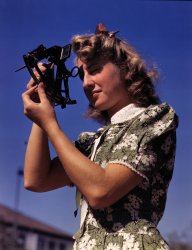
- Meat Market: 1943
- ... of new program." View full size. Print of a photo by Alfred Palmer, Office of War Information. [Thanks to John D. for this sharp scan. - ... Posted by John.Debold - 09/22/2011 - 6:19pm -
![Meat Market: 1943 March 1943. Washington, D.C. Meat rationing at the A&P. "Harold Rowe, Office of Price Administration food rationing chief, sells meat to girl reporter at shopping preview of new program." View full size. Print of a photo by Alfred Palmer, Office of War Information. [Thanks to John D. for this sharp scan. - Dave]
Share the MeatMeat was difficult to obtain during World War II. Much of the available supply was being diverted by the government to US and allied troops abroad, which meant less for civilians at home. The "Share the Meat" program urged Americans to limit their weekly consumption of beef to 2½ pounds per adult, 1½ pounds per child 6 to 12 years old, and ¾ pound per child under 6 years old. It appears you could eat all of the liver, kidneys, fish and poultry you could get.
"Girl Reporter"It strikes me that the "girl reporter" looks to be at least 40.
MeatI'd have to say that 2 1/2 lbs per person a week, especially with no limit on poultry and fish, actually sounds pretty generous to me. I'm not vegan or anything close to it, but I still eat less than 2 lbs of beef a month. Then again, I remember once seeing one of the old wartime propaganda films that spoke of the Japanese diet as "low in fat and sugar" in tones that made it clear this was positive proof of unspeakable evil, and old recipe books give me the impression that people used to eat like every day was Thanksgiving---makes my gallbladder hurt just thinking about it, though I suppose they usually had more physical work to offset it.
WW2 RationingMeat rationing was instituted in Washington D.C. on March 28, 1943. Rather than a set weight per person, families were allotted 16 points per person per week. Different cuts required different numbers of points. For example, a pound of steak or center cut pork chops was 8 points while a pound of hamburger was only 5 points. A pound of spare ribs was 4 points because of the extra bone. The program also included dairy products with a pound of butter requiring 8 points while margarine was 5 points per pound.
A Gallup poll conducted in mid-April of 1943 asked people to rank which rationed products were hardest to cut down on. Meat ranked first. The full list is below. I wonder if gasoline would be #1 today. The 1943 survey noted that "one-half of all car owners said that if necessary they could give up their automobiles without undue hardship."
1. Meat
2. Coffee
3. Gasoline
4. Sugar
5. Butter
6. Canned goods
7. Shoes
8. Fuel Oil
9. Tires
10. Cheese
The human head...Butcher: "The human head weighs eight pounds...here, look!"
Girl Reporter: "Tee-hee!"
What this needs ...This is so begging for a caption contest.
War Economy MythsLest we remain attached to the notion that wartime scarcities lowered our standard of living from 1941-1945, ponder this:
Even though the War Production Board implemented manufacturing bans on certain consumer products during World War II, it is important to realize that our economy grew substantially during this period due to nearly full employment and better cash wages that accrued from war jobs.
Even though Roosevelt warned the country that we could not sustain a consumer economy and a war economy at the same time, Americans did just that. While war spending jumped from $3.6 billion in 1940 (2%GNP) to a peak of $93.4 billion (nearly 50% GNP) in 1944, consumer (civilian) purchases of goods and services grew an astounding 12%.* The War Production Board estimated that labor productivity increased by 25% during the war years, even while millions of men and women were in uniform overseas. The economy was good due to the immense war production spending ending up in the pocketbooks of labor. This can happen again.
Need we fear that the American economy cannot undertake the Herculean task of converting from petroleum to a “next fuel” economy? I think not. With no apologies to the poster of the “hydrogen!” comment attached to “Full Service: 1950’s”, my money is on the Flux Capacitor.
* Bureau of Budget, The United Sates at War, (USGPO, Washington D.C., 1946)
"I must put a goat on."
Winston Churchill (possibly misheard)
Goober Pea
War EconomyI agree with Gooberpea. Notice how many women are wearing fur in some form. As limited as our funds were, even my mother had a winter coat with a huge fur collar.
A&PHe worked at an A&P during WWII as well, in Pittsburgh. My mother recalled that despite the Depression and the war, meat was on the table every night thanks to where her dad worked.
Help For EuropeInterestingly, food rationing in Britain didn't end immediately after WW II. Some food items were limited through the 1950s, with the last item ("yes, we have no bananas") only coming off the list in 1954.
[Australia, too. - Dave]
Now That's a good one!I laughed!
Thank you, Moomin.
(ShorpyBlog, Member Gallery, Stores & Markets, WW2)](https://www.shorpy.com/files/images/scan0022_.thumbnail.jpg)
- Teamwork: 1942
- ... of troops and cargo." 4x5 inch Kodachrome transparency by Alfred Palmer for the Office of War Information. View full size.
What? What? ... Posted by Dave - 03/19/2016 - 10:05am -
![Teamwork: 1942 October 1942. "Men and women make efficient operating teams on riveting and other jobs at the Douglas Aircraft plant, Long Beach, Calif. Most important of the many types of aircraft made at this plant are the B-17F 'Flying Fortress' heavy bomber, the A-20 'Havoc' assault bomber and the C-47 heavy transport plane shown here for the carrying of troops and cargo." 4x5 inch Kodachrome transparency by Alfred Palmer for the Office of War Information. View full size.
What? What?What did you say? what?
Great picture!The composition, the color - just a beautifully composed shot.
Riveting!I just had to say it: This is a riveting photo! ;-)
I love the chiaroscuro, the focussed concentration, the saturated colors, the flesh tones and the gray metal.
They are both beautiful people, too!
MOM!No comment necessary
Blatantly, Utterly PosedTechnically, it's a great feat of photography, but, like many Office of War Information photos, this image is blatantly and utterly posed.
Look at how the supposed "Rosie" is dressed, right down to gleaming shoes. Do you think for a moment that even the most unsophisticated viewer would not instantly recognize this as propaganda ?
Would it not be more informative to have captured the way the work was actually being conducted ? Would that not instill greater appreciation of the war effort in the general public?
On the plus side, the models are at least holding the rivet gun and the bucking bar in the correct alignment.
[These photos were used to produce posters and other promotional materials intended to motivate women to work in war-related industries; in other words, advertising, not documentation. -tterrace]
C-47Dad flew as aerial engineer / crew chief on C-47's in the Pacific War. Battle Stars for Guadalcanal and Northern Solomons. His unit, the "Thirsty 13th" Troop Carrier Squadron island hopped for almost 4 years. Places and air strips long since forgotten.. Dumbea, New Hebrides, New Caledonia, Espiritu Santos, etc. . C-47's were unarmed, flew low and slow, frequently to airstrips carved out of the jungle at the front lines (ie Guadalcanal). His unit lost aircrews. Also, heavy experience with malaria (take your Atabrine !!) and combat fatigue. C-47's were also used to tow gliders to the front lines. Dad made the Sep 7 1942 cover of Life in a "war glider". Dad never discussed much of his experience, but made sure we remembered his lost friends. Mom served in the Atlantic. Greatest generation indeed.
This photo series... famous, yes posed, but served an important function. Front line airmen depended on the manufacturing excellence portrayed in the series.
Posed? Of course!Made a pretty decent living taking photos like that. They were posed because the people who were paying me to take them wanted them that way. The shot we're discussing here is a beaut. Alfred Palmer made what could have been a snoozer most compelling.
When I was taking photos for newspapers, I still would, depending on the situation, ask the subjects to move this way or that way, so you could say those were posed, too. Most of the stuff I shot captured students of the month or new garden club officers. I wanted the subjects, who would be happy to be in the next edition of the paper, to look nice and for the photo to reproduce well as 65dpi black-and-white printed on newsprint.
Sports stuff, crime (what little I ever took) stuff: not posed but not always good, either!
Posed or not...Yes, it's obvious that the photo was posed. As tterrace noted, this and other similar photos seen here on Shorpy were used to create posters and other paraphernalia for the War effort.
But... My Grandmother worked in an aircraft plant during the War. She worked on an assembly team, not riveting but an equally taxing and dirty job. She had several photos I've seen that showed her daily outfits and for the most part it looks like she always tried to look her best, at least in the morning. She actually wore her hair the exact same way.
Yeah, there were (and still are) a lot of dirty jobs but you only have to peruse the photos in Shorpy for a bit to tell that people took the time to dress better, more formal back then.
(The Gallery, Kodachromes, Aviation, Factories, WW2)](https://www.shorpy.com/files/images/SHORPY-1a35338u.thumbnail.jpg)
- Hatchlings: 1942
- ... Kansas City, Kansas." 4x5 Kodachrome transparency by Alfred Palmer for the Office of War Information. View full size.
Re: Love! ... Posted by Dave - 04/17/2014 - 10:36am -
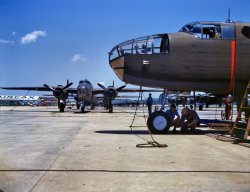
- The Cable Guy: 1942
- ... the existing power supply." 4x5 Kodachrome transparency by Alfred Palmer, Office of War Information. View full size.
Ah, working men I ... Posted by Dave - 08/13/2012 - 5:02pm -
![The Cable Guy: 1942 June 1942. "This husky member of a construction crew building a 33,000 volt power line into Fort Knox is performing an important war service. Thousands of soldiers are in training there, and the new line from a hydroelectric plant at Louisville is needed to supplement the existing power supply." 4x5 Kodachrome transparency by Alfred Palmer, Office of War Information. View full size.
Ah, working menI love the jauntily tipped cap.
Hey...The photo changed from my first comment! What gives?
[I found a second photo (with the same caption) that I liked better. For the record, here's the first guy below. And to the right, an arm probably belonging to Shirtless Guy. - Dave]
Thank goodness for the OWIThe Congress may have wondered why they were spending money for OWI photographers, but I for one am glad they spent that money.
I'll bet copper thieves wouldn't take these guys on.
Still AmazingEvery time a 4x5 Kodachrome is posted, I'm still amazed by the clarity and vividness of the picture. To see people that long ago so clearly really helps to put myself back in that time.
(The Gallery, Kodachromes, WW2)](https://www.shorpy.com/files/images/1a35227u.thumbnail.jpg)
- American Dream: 1942
- ... sealed and stacked for painting." 4x5 nitrate negative by Alfred Palmer for the Office of War Information. View full size.
Invasion I ... Posted by Dave - 06/03/2009 - 7:30am -
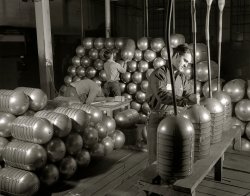
- Under Wraps: 1942
- ... Ridge. View full size. 4x5 Kodachrome transparency by Alfred Palmer for the Office of War Information.
We're gonna turn it on ... Posted by Dave - 08/01/2012 - 1:34pm -
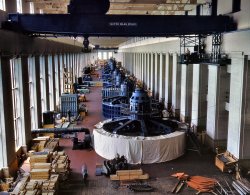
- High Voltage: 1942
- ... View full size. 4x5 Kodachrome transparency by Alfred Palmer, Office of War Information.
Power lines These are telephone or ... Posted by Dave - 08/05/2012 - 9:27am -
![High Voltage: 1942 June 1942. Working on power transmission and utility lines near the TVA hydro- electric plant at Chickamauga Dam or Douglas Dam, Tennessee. View full size. 4x5 Kodachrome transparency by Alfred Palmer, Office of War Information.
Power linesThese are telephone or telegraph lines not power lines.
[There two power lines at the top of the picture. - Dave]
Re: Power linesThe power lines (two of them) are at the top of the picture.
Amateur hourI used to be in charge of live line standards at a professional electrical utility. This nonsense wouldn't be countenanced even for de-energized conductors. These bozos have lashed a delimbed minor tree or big limb to the telephone pole, and the guy on top is doing something silly or another, I cannot imagine what, while belted to the lashed limb! So safe. Hard hat? What's that? Even in 1942, normal utility work standards were far in advance of this horror show, photographed for all posterity to gaze at.
(Technology, The Gallery, Kodachromes, WW2)](https://www.shorpy.com/files/images/1a35245uuu.thumbnail.jpg)
- Highland Park: 1942
- ... of the improvement." Medium format safety negative by Alfred Palmer for the Office of War Information. View full size.
How things ... Posted by Dave - 09/09/2011 - 12:36pm -
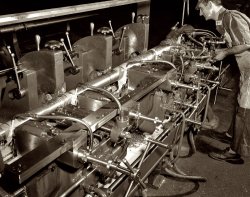
- Army Elbow: 1942
- ... forcing them around a die." 4x5 Kodachrome transparency by Alfred Palmer. View full size.
(The Gallery, Kodachromes, Factories, WW2) ... Posted by Dave - 08/10/2012 - 7:49pm -
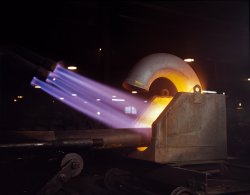
- Incubators of Doom: 1942
- ... products is kept secret." 4x5 Kodachrome transparency by Alfred Palmer. View full size.
Secret Ya wouldn't want anyone to know we ... Posted by Dave - 08/30/2012 - 2:02pm -
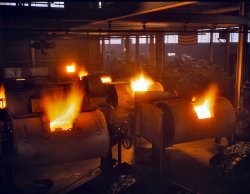
- The New Chrysler: 1942
- ... the very finest of tolerances." Medium format negative by Alfred Palmer for the Office of War Information. View full size.
Chrysler ... Posted by Dave - 09/09/2011 - 12:37pm -
